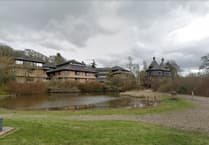An impressive stainless steel statue commemorating the world-renowned hymnologist, William Williams, Pantycelyn, has been erected in the centre of Llandovery.
It stands over 10 feet high outside Y Gannwyll, which is home to the town’s museum.
The statue, which displays a selection of Williams’s most famous hymns, is the work of Gideon Petersen, one of the two brothers who created the statue of Llywelyn ap Gruffydd Fychan on the nearby castle mound, and it was paid for by the town council.
In a special ceremony on Friday, May 5, a ribbon on the statue of William Williams was cut by his descendant Cecil Williams, and his wife Cynthia. Other family members were also present. Cecil Williams, who still lives in the old family home of Pantycelyn, Pentre-tŷ-gwyn, said that hundreds of people from all over the world visit Pantycelyn every year.

“The memorial is a beautiful sculpture,” said Mr Williams. “It’s good to have such a fitting tribute to my predecessor in his hometown.”
Another speaker was the Venerable Randolph Thomas, Chairman of the Council at the University of Wales Trinity Saint David. During ten years as Archdeacon of Brecon, one of his responsibilities was the church at Talgarth.
“It was the church where Howell Harris was converted on the steps of the altar, and where William Williams was converted in the graveyard on hearing Howell Harris preach,” he said. “Trinity Saint David is proud to support the development of this memorial, which honours one of the leading hymnologists of our language and country.”
Professor E. Wyn James, an expert on the life and work of Pantycelyn, spoke of his enormous influence.
He said: “Wales would not be the land of song today if it weren’t for his hymns. Although William Williams lived in the vicinity of Llandovery all his life, he rode many thousands of miles on horseback every year for forty years to promote the gospel.
“He is also a person of international importance. A third of the world’s population are now Christians and one of their favourite hymns is ‘Guide me, O Thou great Jehovah’. Pantycelyn’s words are sung every week in all parts of the world in different languages. He’s a giant in Wales, but he is an international giant as well. He is one of the most important Welshmen of all time.”
William Williams wrote over 900 hymns and 90 diverse and innovative literary works before his death in 1791. Although the William Williams Memorial Chapel was in Llandovery, it was felt that something more prominent was needed, and in a location where more people see it.
Some prominent Welsh people complained that there had been insufficient recognition for Williams Pantycelyn during the tricentenary of his birth in 2017. A petition was launched, which was signed by several thousand people, but because of the pandemic it took six years to bear fruit.
The town and county councillor, Handel Davies, who is coming to the end of his term as mayor of Llandovery, was responsible for leading the campaign.
“It continues to be quite a journey to try to give more prominence to the rich history of the area, and the richest person we have is undoubtedly William Williams, Pantycelyn,” said Cllr Davies.
“The unveiling of this sculpture was deliberately timed to coincide with the visit of the Urdd National Eisteddfod to Llandovery at the end of the month. We hope that it will attract people into the town itself, not only during the Eisteddfod but at all times in the future.”
The unveiling activities ended with the Llandovery Male Voice Choir singing two of Pantycelyn’s hymns.



